Geometry in place: Sam Jacobs & Wassef Boutros-Ghali
Two architects who have turned their hand to fine art are
exhibited separately in London, but in coincidental geometric conversation with
one another. Will Jennings considers how Sam Jacob’s paintings, which overlay geometric forms into found landscape
scenes, speak to modernist abstractions by Wassef Boutros-Ghali.
Wassef Boutros-Ghali never intended to be an architect. His desire
and hopes were to be a visual artist, though upon being dissuaded by his family
in such a career he then studied Architecture at Cairo University, graduating
in 1946 before spending the following year visiting Le Corbusier’s projects
across Europe alongside other modernist architectures and art exhibitions.
His family are perhaps more well-known than the artist himself. His grandfather Boutros Gali Pasha was Egypt’s Prime Minister between 1908 and 1910, while his brother Boutros Boutros-Ghali is the former General Secretary of the United Nations. Wassef Boutros-Ghali didn’t see his future lying in the political field, though much of his architectural career was spent working for UNESCO and the United
Boutros-Ghali was interested in modernist forms – both aesthetic and political – which can be seen in both his first architectural project and many of the works he went on to paint, particularly in works over the last 15 years in which geometry is more integral to composition. These works have been painted since the artist returned to Cairo from New York, to live and work in the Dar El Nil building by the banks of the Nile, a modernist structure he designed aged 26, completed in 1950.
![]()
![]()
![]()
![]()
Sam Jacob is an architect who has never shied away from intermingling his art and writing with his built practice. Not only was Jacob the first contributor to recessed.space (00001), he is the former director of FAT architects, where he worked on an array of built works as well as design and art installations, one of the firm’s final projects was A House for Essex, a collaboration with artist Grayson Perry as fairy-tale holiday retreat in the Essex countryside. Now director at Sam Jacob Studio, which he founded in 2014, he is still as comfortable designing buildings including recent home and community space Ivy Street, or for exhibitions such as recent The Horror Show! at London’s Somerset House.
![]()
In his work on show at commercial gallery Betts Project, the architecture is removed of all detail and decoration, appearing as black geometry towering above and within romantic landscapes. In Against Nature (the Paintings), Jacobs oil-paints over 44 second-hand and somewhat cliché-picturesque landscape settings with dark, brooding, graphic interjections, Jacob imbues both the calm natural settings and polite aesthetics of original paintings with something altogether more sinister.
In augmenting the picturesque, Jacob is questioning the politics of land, ownership, and taste. The black interjections are forms derived from the geometry of the canvas, using classical forms of spatial division – halves, thirds, diagonals, and perspectival ratios – to break into the perception of a picture-postcard view. By juxtaposing with the aesthetic representation, but logically and rigidly tying into the size and shape of the canvas upon which it is painted, Jacob has created other-worldly inventions which are at once unsettling but seemingly entirely rational and relaxing.
![]()
![]()
![]()
![]()
In the seven paintings exhibited in a small anteroom at The Arts Club, Boutros-Ghali similarly derives geometry from landscape – whether those of the emerging modernisms of 20th century Egypt, or the imagined landscapes of post-colonial abstraction and a desire to form a new arrangement of space from ingredients shaped by others.
The canvasses, painted between 2001 and 2012, are unapologetically abstract studies in form and colour, but it is impossible to not seek in his arrangements architectural shadows, junctions, and ideas filling the mind of an artist not only from his studies and practice, but his UN work taking him across Tunisia, Algeria, Morocco, and the Sudan, all countries with the historic landscapes and buildings he was tasked with researching alongside modernist new architectural forms.
![]()
Both architecture and landscape in Boutros-Ghali’s canvases are dismantled and reformed, unrecognisable from source inspirations and seemingly in search of a new way for Egyptian vernacular colour fields and chromatics to marry with modernist arrangements and geometry from the global north – aesthetically continuing similar political aims of his grandfather and brother.
![]()
![]()
![]()
![]()
Jacobs does not disguise or diffuse the conjoining of historic setting and modern addition, instead celebrating in the differences and conversations between. In a second series of works, Ritual Litter, the architect-artist overlays antique prints of neolithic stone structures with geometric acrylic shapes. They read as offcuts of an architectural drawing from his studio, or discarded components of a Malevich arrangement, but here they marry awkwardly with the gravity and forms of millennia old stone circles and monuments – and all the psychogeographical, pagan, and mythological weight they carry. What do the additions do here? In some images they seem to be supporting or propping up the historic components, much like the modern props and scaffolding which supports the boughs and branches of the aged Great Oak in Sherwood Forest. In other images, they seem to parasitically sit upon the older stones, mimicking in unapologetically bold geometry and colour. But, on both cases, there seems to be symbiosis, not threat or abuse.
The two exhibitions play with geometry and how it can be utilised to consider history of place or idea with both nuance and progression. Both artists play with the duality of modernist geometry, drawing from and working with antecedent forms towards a kind of harmony which celebrates difference, not seeking to disappear.
His family are perhaps more well-known than the artist himself. His grandfather Boutros Gali Pasha was Egypt’s Prime Minister between 1908 and 1910, while his brother Boutros Boutros-Ghali is the former General Secretary of the United Nations. Wassef Boutros-Ghali didn’t see his future lying in the political field, though much of his architectural career was spent working for UNESCO and the United
Boutros-Ghali was interested in modernist forms – both aesthetic and political – which can be seen in both his first architectural project and many of the works he went on to paint, particularly in works over the last 15 years in which geometry is more integral to composition. These works have been painted since the artist returned to Cairo from New York, to live and work in the Dar El Nil building by the banks of the Nile, a modernist structure he designed aged 26, completed in 1950.
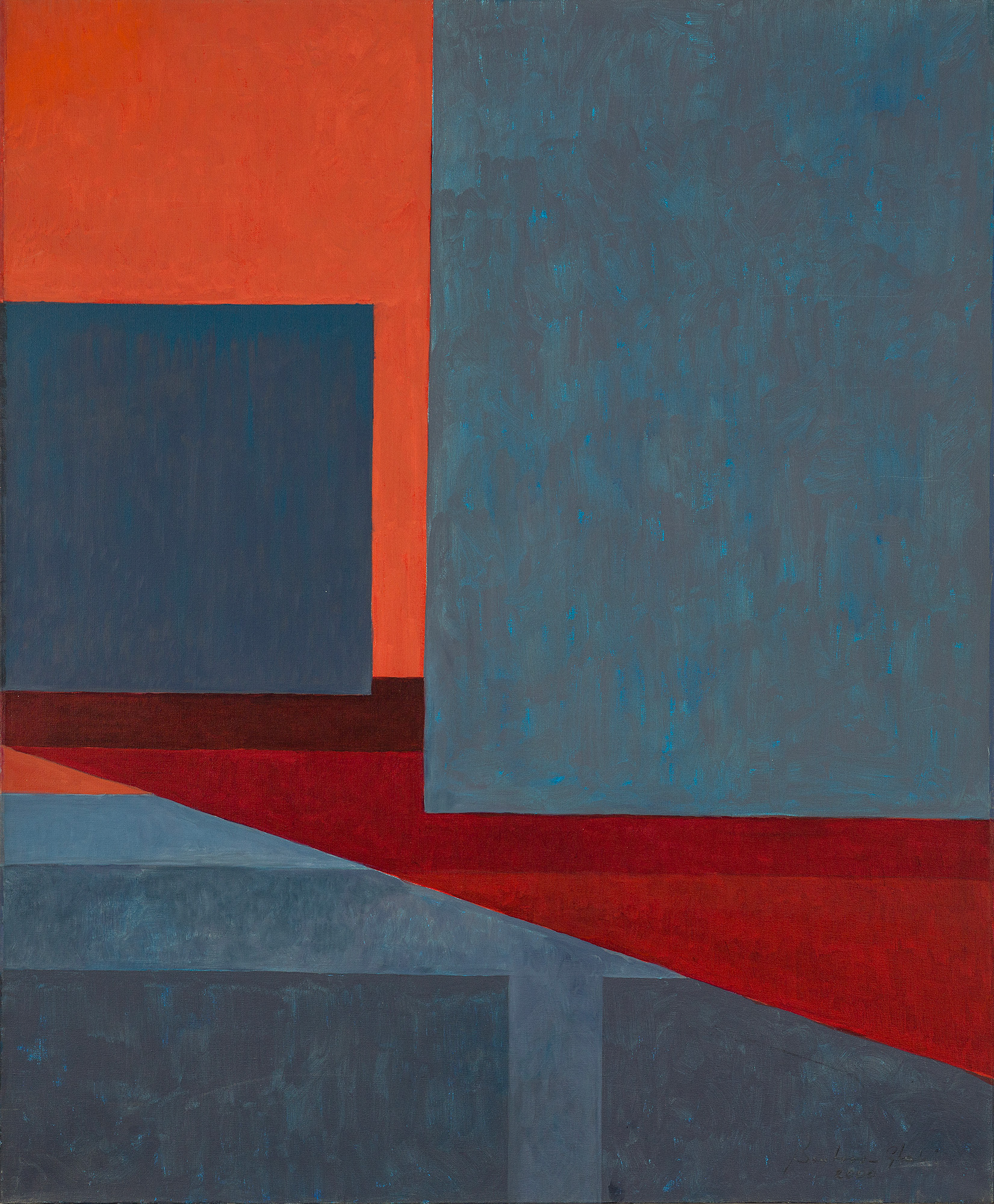
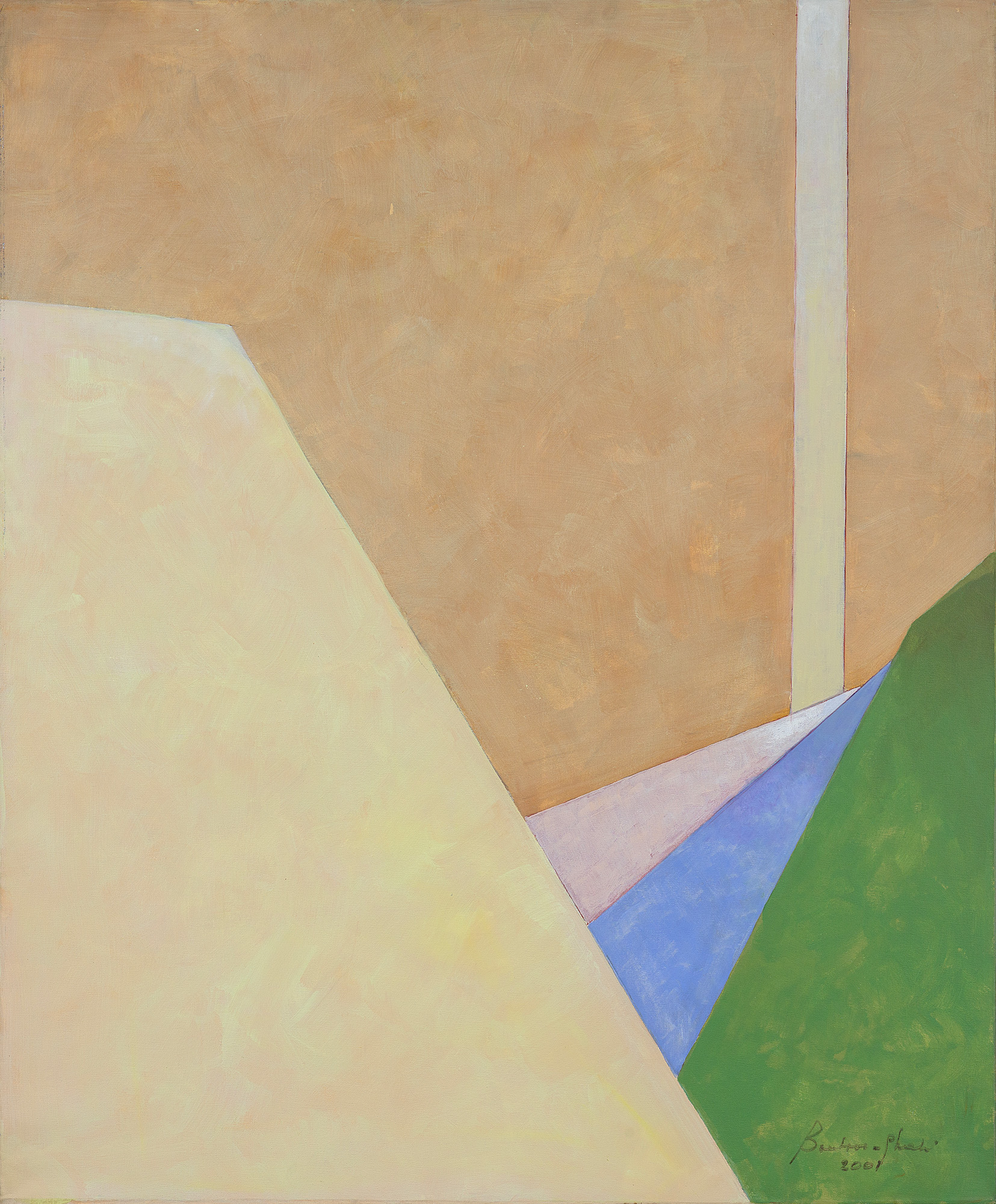


Sam Jacob is an architect who has never shied away from intermingling his art and writing with his built practice. Not only was Jacob the first contributor to recessed.space (00001), he is the former director of FAT architects, where he worked on an array of built works as well as design and art installations, one of the firm’s final projects was A House for Essex, a collaboration with artist Grayson Perry as fairy-tale holiday retreat in the Essex countryside. Now director at Sam Jacob Studio, which he founded in 2014, he is still as comfortable designing buildings including recent home and community space Ivy Street, or for exhibitions such as recent The Horror Show! at London’s Somerset House.

In his work on show at commercial gallery Betts Project, the architecture is removed of all detail and decoration, appearing as black geometry towering above and within romantic landscapes. In Against Nature (the Paintings), Jacobs oil-paints over 44 second-hand and somewhat cliché-picturesque landscape settings with dark, brooding, graphic interjections, Jacob imbues both the calm natural settings and polite aesthetics of original paintings with something altogether more sinister.
In augmenting the picturesque, Jacob is questioning the politics of land, ownership, and taste. The black interjections are forms derived from the geometry of the canvas, using classical forms of spatial division – halves, thirds, diagonals, and perspectival ratios – to break into the perception of a picture-postcard view. By juxtaposing with the aesthetic representation, but logically and rigidly tying into the size and shape of the canvas upon which it is painted, Jacob has created other-worldly inventions which are at once unsettling but seemingly entirely rational and relaxing.
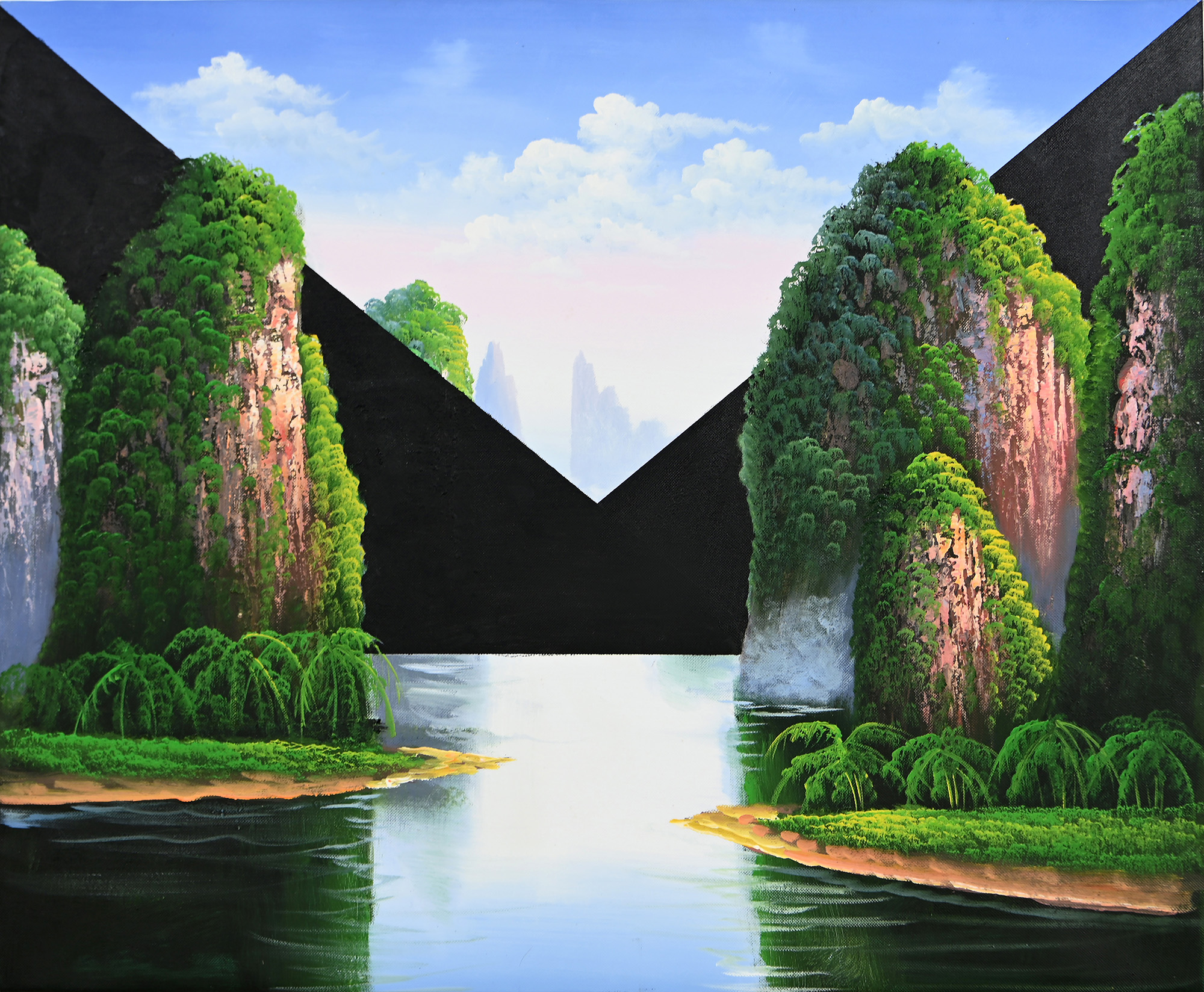
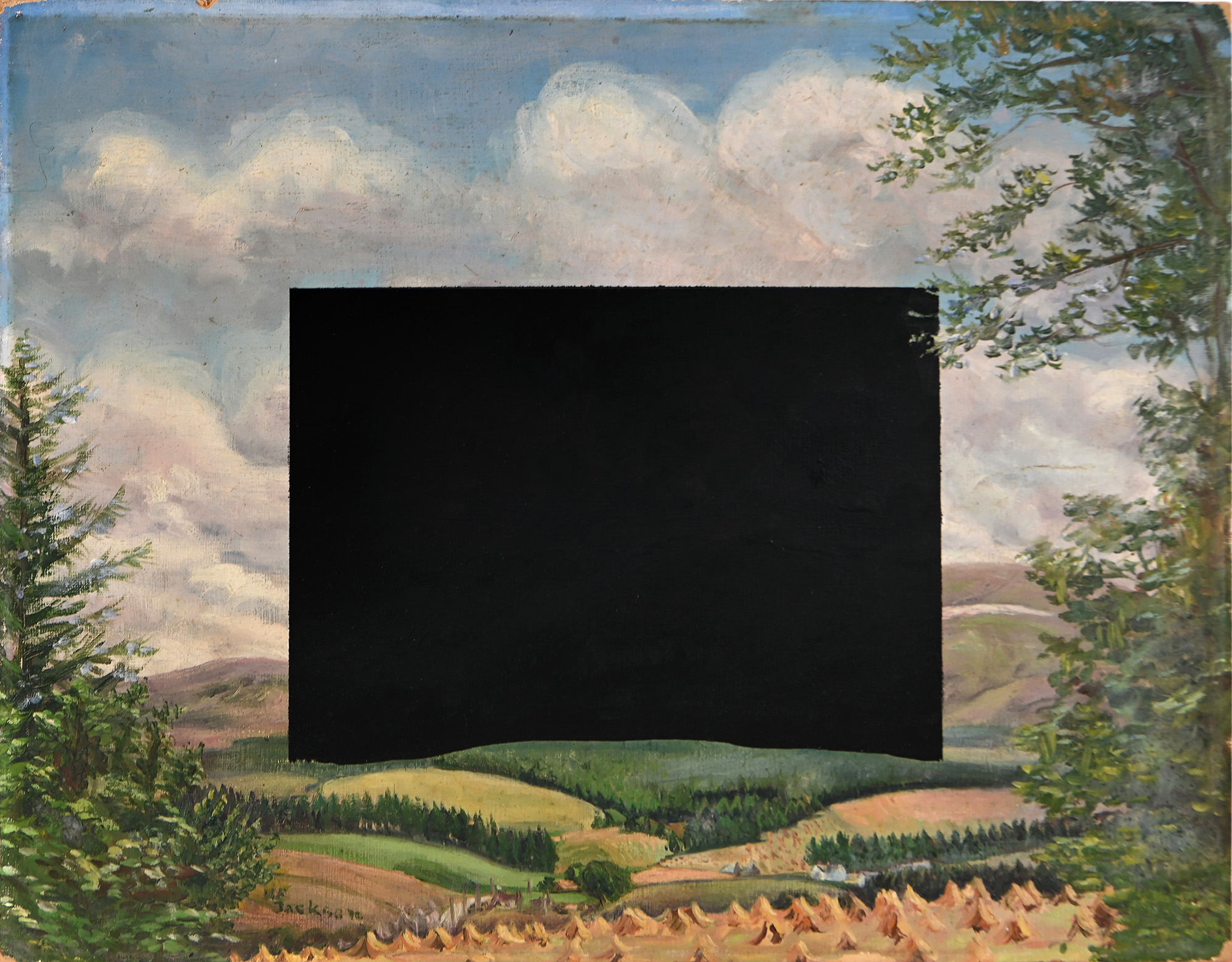
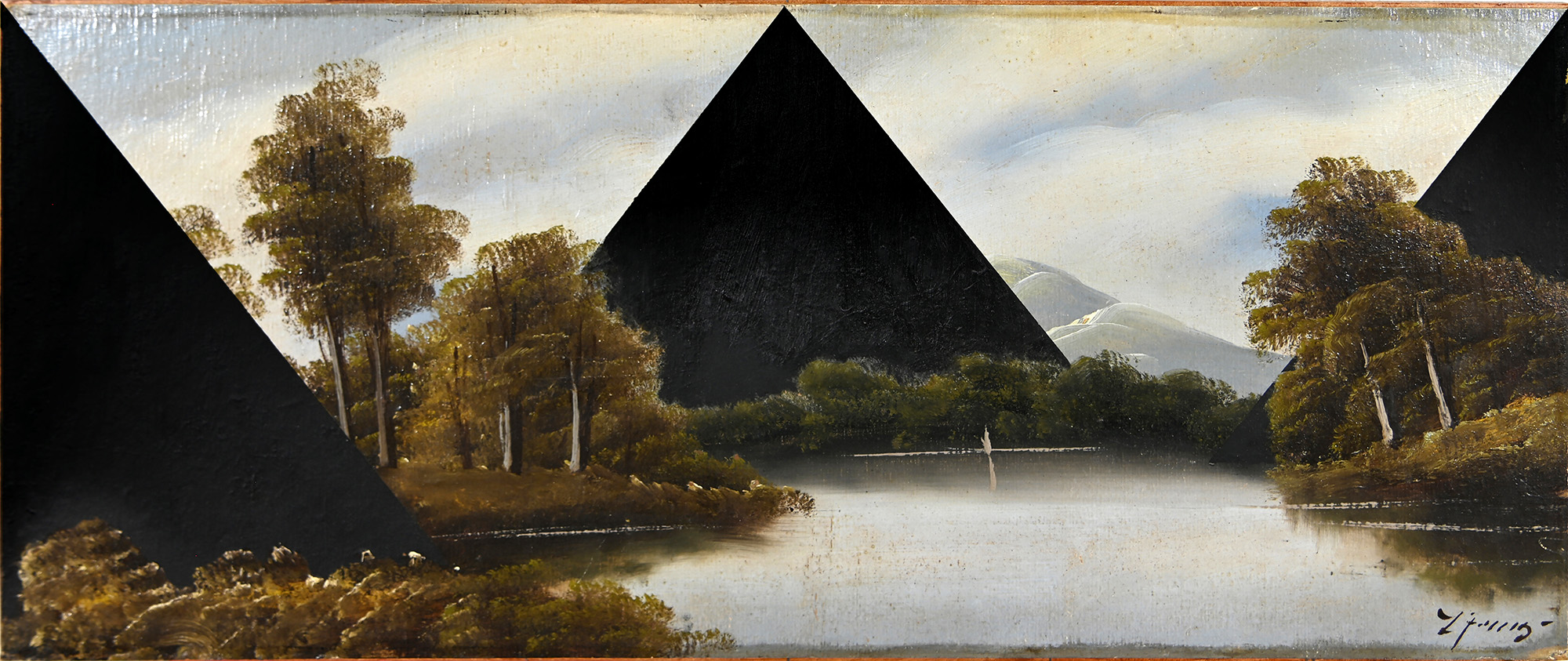
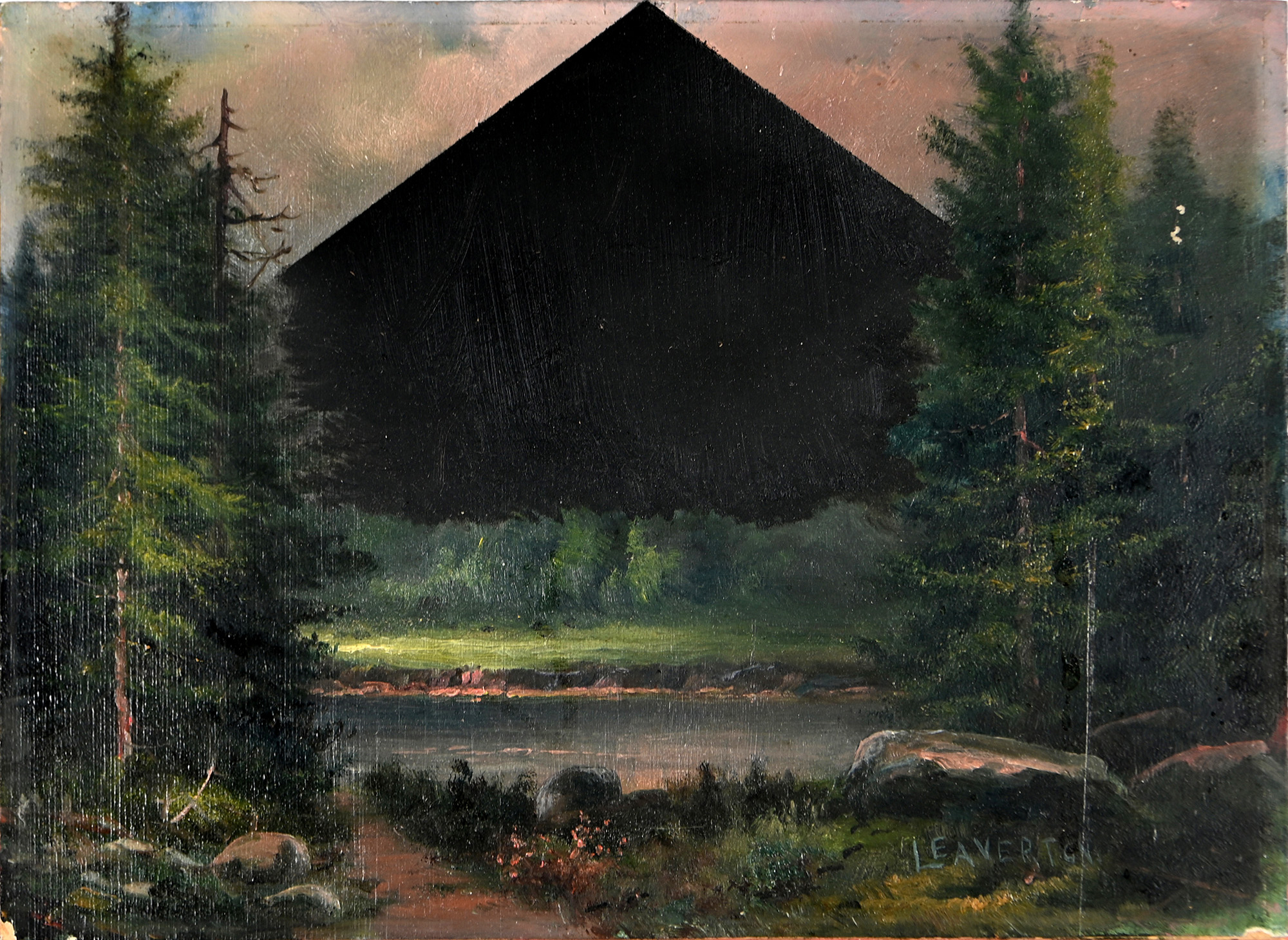
In the seven paintings exhibited in a small anteroom at The Arts Club, Boutros-Ghali similarly derives geometry from landscape – whether those of the emerging modernisms of 20th century Egypt, or the imagined landscapes of post-colonial abstraction and a desire to form a new arrangement of space from ingredients shaped by others.
The canvasses, painted between 2001 and 2012, are unapologetically abstract studies in form and colour, but it is impossible to not seek in his arrangements architectural shadows, junctions, and ideas filling the mind of an artist not only from his studies and practice, but his UN work taking him across Tunisia, Algeria, Morocco, and the Sudan, all countries with the historic landscapes and buildings he was tasked with researching alongside modernist new architectural forms.
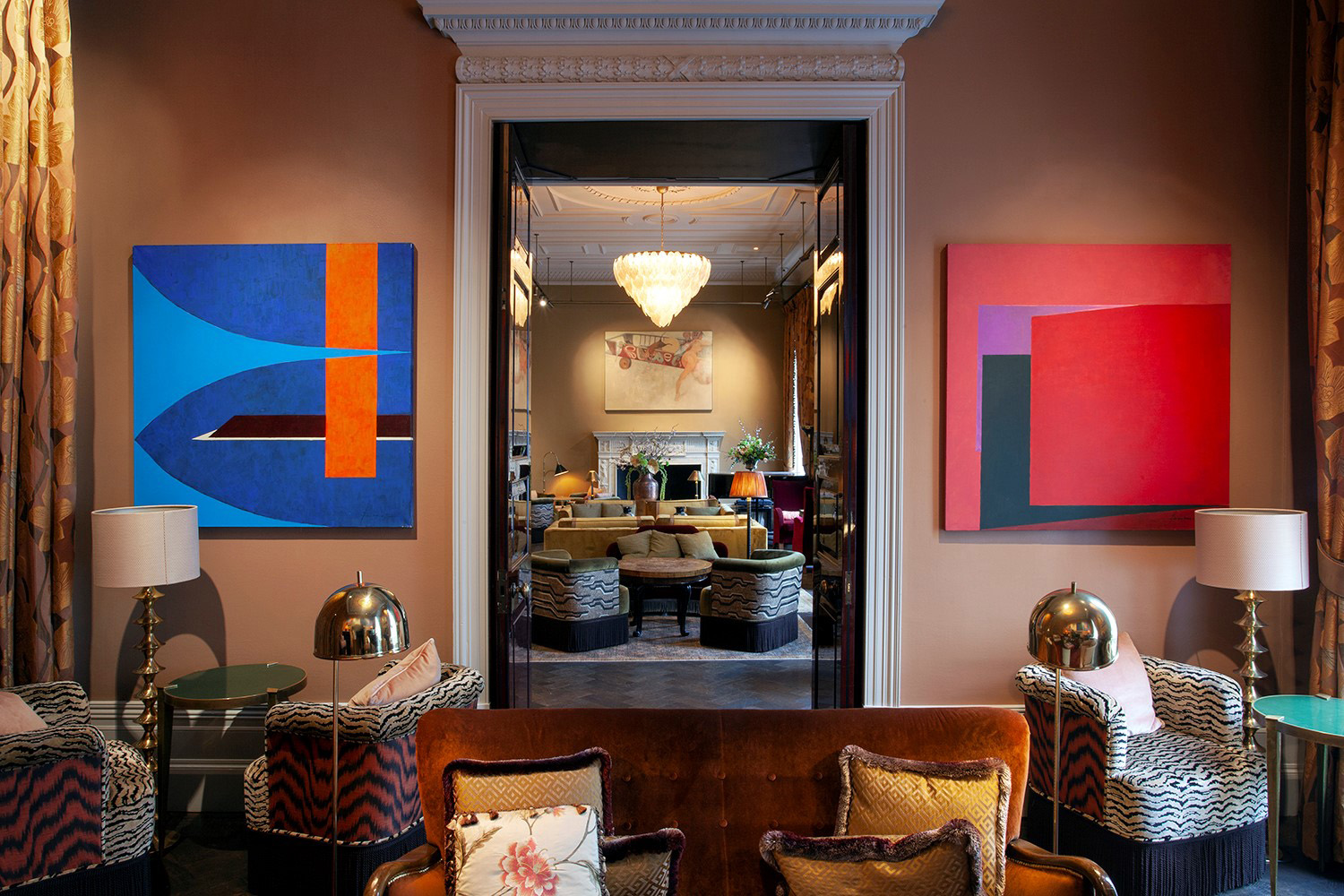
Both architecture and landscape in Boutros-Ghali’s canvases are dismantled and reformed, unrecognisable from source inspirations and seemingly in search of a new way for Egyptian vernacular colour fields and chromatics to marry with modernist arrangements and geometry from the global north – aesthetically continuing similar political aims of his grandfather and brother.


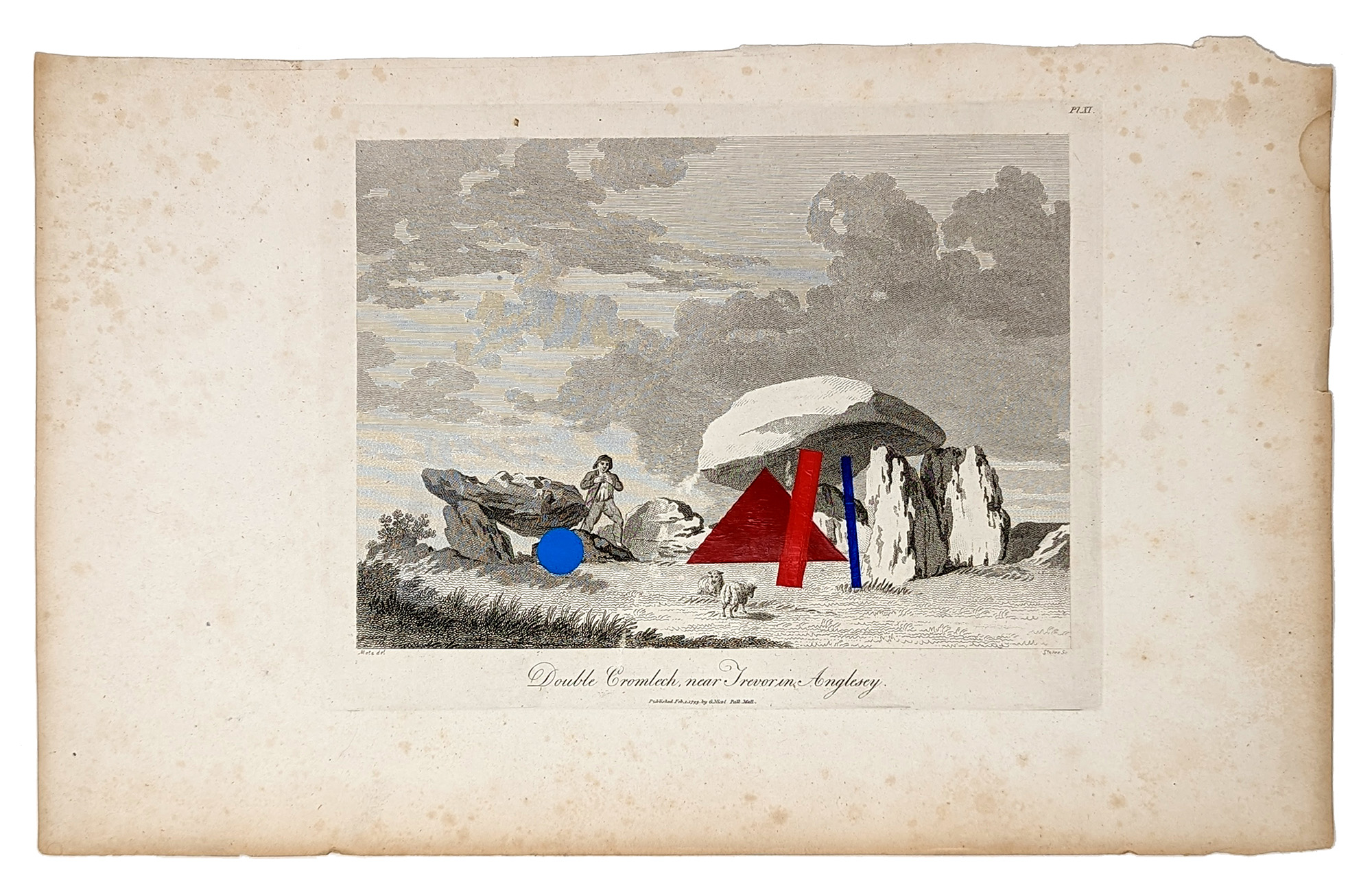

Jacobs does not disguise or diffuse the conjoining of historic setting and modern addition, instead celebrating in the differences and conversations between. In a second series of works, Ritual Litter, the architect-artist overlays antique prints of neolithic stone structures with geometric acrylic shapes. They read as offcuts of an architectural drawing from his studio, or discarded components of a Malevich arrangement, but here they marry awkwardly with the gravity and forms of millennia old stone circles and monuments – and all the psychogeographical, pagan, and mythological weight they carry. What do the additions do here? In some images they seem to be supporting or propping up the historic components, much like the modern props and scaffolding which supports the boughs and branches of the aged Great Oak in Sherwood Forest. In other images, they seem to parasitically sit upon the older stones, mimicking in unapologetically bold geometry and colour. But, on both cases, there seems to be symbiosis, not threat or abuse.
The two exhibitions play with geometry and how it can be utilised to consider history of place or idea with both nuance and progression. Both artists play with the duality of modernist geometry, drawing from and working with antecedent forms towards a kind of harmony which celebrates difference, not seeking to disappear.
Wassef Boutros-Ghali [b. 1924, Cairo, Egypt] is a Cairo-based painter who, despite being born into a family of politicians, showed an early proficiency in the arts. He later joined the studio of Jaro Hilbert, a classically trained painter who became Boutros-Ghali’s mentor. Eventually, Boutros-Ghali left his political legacy to pursue a career in architecture. He served as a technical consultant for the environment and urbanism with the United Nations, and executed building in Egypt, Ethiopia, Saudi Arabia, Kuwait and the Sudan. All the while, he continued his artistic practice.
His evolution as an artist was also precipitated by restrictive circumstance. Political revolution and a necessary relocation in 1963 constrained his use of materials and access to supplies. Yet, he created an experimental body of work that continued to inform his practice. His time in New York in 1971 also elevated his practice as he was reinvigorated by the New York art scene of the time. Larger canvases and abstracted forms became more prominent. In 1985, he returned to Cairo where he continues to use vibrant colors to show motion and energy. His compositions imply scenes of myth and reality, balancing the simplicity of daily life with imagination with abstraction.
www.wboutrosghaliart.com
Sam Jacob is the leader of Sam Jacob Stusio, Professor of Architecture at UIC & Visiting Professor at Yale School of Architecture. He was co-curator of the British Pavilion in Venice (2014), is columnist and critic for Dezeen and Art Review as well as Contributing Editor for Icon magazine. Previously, Sam was a founding director of FAT Architecture.
www.samjacob.com
The Arts Club was founded in 1863 to provide a sanctuary for those with a professional or amateur relationship with the Arts, Literature or Sciences. Since then, it has garnered international recognition as an exciting space for creatives, thought leaders & discerning thinkers to come together in the heart of London.
At the core of the club is an extensive contemporary art collection which honours emerging and established international artists. A rotating exhibition, talks and events programme builds upon this diverse line-up, offering a reflection of the art world’s continually evolving landscape.
www.theartsclub.co.uk
Betts
Project is a London-based contemporary art gallery specialising in
architecture, founded in 2013 by Marie Coulon.
The
concept behind Betts Project is to introduce both a specialist audience and
wider public to new ways of discovering and thinking about architecture,
through the exhibition and promotion of materials integral to architecture –
largely drawings, but also models and other forms of representation. It aims to
support and promote work by established and emerging international architects,
as well as lesser known or overlooked practices still very much relevant to the
contemporary discourse.
www.bettsproject.com
Will Jennings is a London based writer, visual artist, and educator interested in cities, architecture, and culture. He has written for the RIBA Journal, the Journal of Civic Architecture, Quietus, The Wire, the Guardian, and Icon. He teaches history and theory at UCL Bartlett and Greenwich University, and is director of UK cultural charity Hypha Studios.
www.willjennings.info
www.samjacob.com
The Arts Club was founded in 1863 to provide a sanctuary for those with a professional or amateur relationship with the Arts, Literature or Sciences. Since then, it has garnered international recognition as an exciting space for creatives, thought leaders & discerning thinkers to come together in the heart of London.
At the core of the club is an extensive contemporary art collection which honours emerging and established international artists. A rotating exhibition, talks and events programme builds upon this diverse line-up, offering a reflection of the art world’s continually evolving landscape.
www.theartsclub.co.uk
Betts
Project is a London-based contemporary art gallery specialising in
architecture, founded in 2013 by Marie Coulon.
The
concept behind Betts Project is to introduce both a specialist audience and
wider public to new ways of discovering and thinking about architecture,
through the exhibition and promotion of materials integral to architecture –
largely drawings, but also models and other forms of representation. It aims to
support and promote work by established and emerging international architects,
as well as lesser known or overlooked practices still very much relevant to the
contemporary discourse.
www.bettsproject.com
Will Jennings is a London based writer, visual artist, and educator interested in cities, architecture, and culture. He has written for the RIBA Journal, the Journal of Civic Architecture, Quietus, The Wire, the Guardian, and Icon. He teaches history and theory at UCL Bartlett and Greenwich University, and is director of UK cultural charity Hypha Studios.
www.willjennings.info
www.bettsproject.com
Will Jennings is a London based writer, visual artist, and educator interested in cities, architecture, and culture. He has written for the RIBA Journal, the Journal of Civic Architecture, Quietus, The Wire, the Guardian, and Icon. He teaches history and theory at UCL Bartlett and Greenwich University, and is director of UK cultural charity Hypha Studios.
www.willjennings.info
visit
Against Nature by Sam Jacob is exhibited at Betts Project, London, until 15 April 2023. All works are for sale, with further information available at:
www.bettsproject.com/exhibitions#/samjacob-againstnature
Wassef Boutros-Ghali is exhibited at The Arts Club, London, until 7 May 2023. Visit by appointment, information at:
www.theartsclub.co.uk/art-category/exhibition-programme
images
Sam Jacob images Courtesy the artist & BettsProject
Wassef Boutros-Ghali artworks Wassef Boutros-Ghali at The Arts Club, London, 22 February –
29 April 2023, theartsclub.co.uk
Wassef Boutros-Ghali installation view Wassef Boutros-Ghali at The Arts Club, London, UK, 2023. Photo by Kate Elliott
publication date
25 February 2023
tags
The Arts Club, Betts Project, Wassef Boutros-Ghali, Le Corbusier, Egypt, Geometry, Graphic, House for Essex, Sam Jacob, Will Jennings, Landscape, Modernism, Neolithic, Painting, Stones, UN, UNESCO
www.bettsproject.com/exhibitions#/samjacob-againstnature
Wassef Boutros-Ghali is exhibited at The Arts Club, London, until 7 May 2023. Visit by appointment, information at:
www.theartsclub.co.uk/art-category/exhibition-programme


